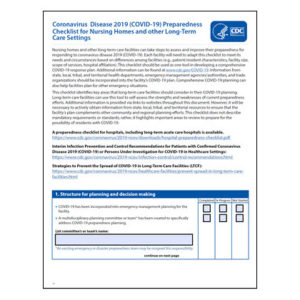CDC: Protect Staff With Underlying Conditions Against COVID-19
The Centers for Disease Control & Prevention (CDC) has made clear that residents of skilled nursing facilities (SNFs), nursing facilities (NFs), and other senior care facilities have a significantly higher risk of experiencing severe illness, requiring hospitalization, and even dying if infected with SARS-CoV-2, the virus that causes COVID-19. However, the usual suspects of congregate living and age aren’t the only risk factors—and these other risk factors also can impact the severity of COVID-19 illness in facility staff.

John T. Brooks, MD, chief medical officer of the COVID-19 Emergency Response Team, Centers for Disease Control and Prevention
“In general in medicine, we know that people who have certain underlying medical conditions, regardless of their age, are also at increased risk when faced with a respiratory infection,” says John T. Brooks, MD, chief medical officer of the COVID-19 Emergency Response Team at the Centers for Disease Control and Prevention. “Consider a young man with cystic fibrosis, a young woman with asthma, or a severely overweight young adult. These are persons who may be young, but these underlying conditions really increase their inability to manage a severe respiratory infection well.”
Based on limited U.S. data available as of March 28, “the percentage of COVID-19 patients with at least one underlying health condition or risk factor [e.g., smoking] was higher among those requiring intensive care unit (ICU) admission (358 of 457, 78%) and those requiring hospitalization without ICU admission (732 of 1,037, 71%) than … among those who were not hospitalized (1,388 of 5,143, 27%),” says the COVID-19 Response Team in “Underlying Health Conditions Among Patients With Coronavirus Disease 2019 — United States, February 12 – March 28, 2020” from the March 31 Morbidity and Mortality Weekly Report (MMWR). In addition, 184 deaths occurred among all COVID-19 patients with complete information on underlying conditions or risk factors, and 94 percent (173) of those deaths involved patients with at least one underlying condition.
Consistent with findings from China and Italy, “these preliminary findings suggest that, in the United States, persons with underlying health conditions or other recognized risk factors for severe outcomes from respiratory infections appear to be at a higher risk for severe disease from COVID-19 than are persons without these conditions,” says the team.
The bottom line is that staff, as well as residents, may have underlying comorbidities that can affect the severity of COVID-19 illness regardless of the person’s age, says Brooks. “This is an important consideration because we want to protect our healthcare workforce. These people are on the front lines, heavily exposed to this infection, and in that way are at high risk of acquiring the infection. We want to do what we can to keep them active and helping us, but we also want to protect them as best we can. It is incumbent on us to protect them—even more so than a person who does not have an underlying medical condition or isn’t in the older age population.”
The CDC doesn’t offer specific guidance on how to protect these workers. Each provider should develop its own policy based on personnel practices to determine how to best manage the protection of staff who are at greater risk, suggests Brooks. “[This could include] making sure that persons with some of these underlying medical conditions have access to the best available personal protective equipment (PPE) or that people in these positions are moved to other work where they are not necessarily where they could be exposed to someone with COVID-19. It can be a thorny issue because a healthcare organization has to be careful not to inadvertently disclose that one of their employees has an underlying medical condition. It could be a privacy issue.”
Where the biggest risks may be
Based on the literature and prior experience with respiratory infections, the CDC has developed a list of high-risk underlying conditions, which may be updated as more data is available, that providers should consider when assessing risks to both residents and staff. Here are key highlights:
* Chronic lung disease or moderate to severe asthma. Chronic lung disease is one of the three most frequently reported underlying conditions among U.S. COVID-19 patients with at least one underlying condition, according to the March 31 MMWR report. “Chronic lung diseases, including chronic obstructive pulmonary disease (COPD), which includes emphysema and chronic bronchitis, as well as moderate to severe asthma, idiopathic pulmonary fibrosis, and cystic fibrosis, may be associated with severe illness and poorer outcomes for COVID-19,” says Georgina Peacock, MD, MPH, FAAP, the lead of the CDC’s COVID-19 Response At-Risk Task Force. “Based on data from other viral respiratory infections, COVID-19 might cause exacerbations of chronic lung disease, leading to severe illness.”

Georgina Peacock, MD, MPH, FAAP, lead of the CDC’s COVID-19 Response At-Risk Task Force
Currently, the CDC doesn’t know if patients who have mild or well-controlled asthma might also experience worsening of their asthma symptoms when exposed to COVID-19, points out Peacock.
It’s also worth noting that “tobacco smoking can increase the risk for developing lung disease, making it harder to recover from infections such as COVID-19,” says Peacock. Any residents or staff who smoke should be encouraged to consider quitting, she adds. “They can call 1-800-QUIT-NOW or visit the CDC website for more information.”
* Serious heart conditions. Cardiovascular disease also is one of the three most frequently reported underlying conditions among U.S. COVID-19 patients. “Currently, we know that certain serious heart disease does put people at higher risk for severe illness from COVID-19,” says Peacock.
“What our limited data from the U.S., China, and other countries has shown us is that there are people with certain kinds of serious heart disease, such as heart failure, that put them at higher risk for severe illness,” she points out. “This is consistent with other respiratory viral illnesses that can lead to decompensation of heart failure, which then leads to more severe illness. We also know that influenza patients with heart failure have a significantly higher mortality than those without heart failure.”
Some other conditions that may increase the risk of severe illness might include coronary artery disease, congenital heart disease, cardiomyopathies, and pulmonary hypertension, says Peacock. “We do have observational knowledge that there is an increased risk with hypertension, but we don’t know whether having hypertension alone does increase that risk for severe illness from COVID-19,” she adds. “We are working to understand whether hypertension is an independent risk factor. What we do know is that people with hypertension should take their blood pressure medicines as directed and work with their primary care provider to make sure that their blood pressure is as well-controlled as possible.”
* Diabetes. Diabetes mellitus is the most frequently reported underlying conditions among U.S. COVID-19 patients, according to the MMWR report.
Other high-risk comorbidities include:
- Immunocompromised. “That can be due to cancer treatment, advanced or uncontrolled HIV infection, organ transplantation, and chronic heavy steroid use,” says Brooks.
- Severe obesity. “That is defined as a body mass index greater than or equal to 40,” says Brooks.
- Renal failure.
- Liver disease.
How much risk does each comorbidity carry?
“Unfortunately, right now there are insufficient data for us to look at each risk independent of the others and understand how much risk that may translate into in terms of a patient’s overall condition and/or projected outcome,” says Sapna Bamrah Morris, MD, MBA, FIDSA, a medical epidemiologist on the clinical team of the CDC’s COVID-19 Response Health Systems Worker Safety Task Force and a captain in the U.S. Public Health Service. “We are actively working both epidemiologically and through clinical investigations to understand that risk and how [comorbidities] manifest themselves in the presentation of disease here in the United States.”
People of any age with underlying medical conditions, particularly if these conditions are not well-controlled, might be at risk for severe illness,” stresses Morris. “While we do understand that age does correlate with severe illness, we want to emphasize that these underlying conditions are important regardless of the age in which we are seeing them.”
The intersection of age and comorbidity really comes into play in people over 65, adds Brooks. “In the United States so far, people over 65 have comprised 31 percent of the cases; half of hospitalizations; about half of those who have been admitted to ICUs; and about 80 percent of those who have died. And it is because often people who are older often suffer not just from one but from multiple comorbidities. That multiplier effect is something we need to pay attention to when considering who we need to watch out for and take special care treating and taking care of.”
Questions? Call CDC’s COVID-19 clinical call centers
Providers that need additional help with any CDC guidance related to COVID-19 can call the CDC COVID-19 clinical call center 24 hours a day, seven days a week at (770) 488-7100. The trained clinicians who staff the call center not only can answer questions themselves, they also can bring together providers with health departments and CDC clinicians to discuss solutions and help providers make informed decisions.
Note: CDC officials spoke during the March 27 CDC Clinician Outreach and Communication Activity (COCA) call, Underlying Medical Conditions and People at Higher Risk for COVID-19. Learn about upcoming calls here.

Caralyn Davis is a freelance writer specializing in the post-acute care sector. Email her at: caralynd@outlook.com.
Related Articles
Topics: Accountable Care Organizations (ACOs) , Clinical , Featured Articles , Risk Management , Staffing










